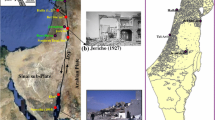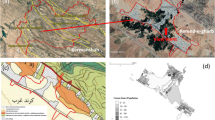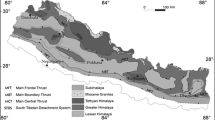Abstract
Risk evaluation and loss analysis is key in foreseeing the impact of disasters caused by natural hazards and may contribute effectively in improving resilience in a community through the pre-evaluation of preparedness and mitigation actions. The pilot study presented herein is for the Chilean city of Iquique, which is located at the core of a seismic gap that extends from south Perú to north Chile, and has strategic geopolitical and economic importance for the country. The region was hit April 1, 2014, by an \(M_\mathrm{w}\) 8.2 earthquake that caused only moderate damage, but seismological evidence suggests that there is still a potential for a much larger event in the region. Therefore, a careful damage assessment study is fundamental to anticipate the possible physical, social, and economic consequences that Iquique may face in the future. In this work, the HAZUS-MH platform was adapted and used to simulate a set of ten plausible physics-based future seismic scenarios with magnitudes ranging from \(M_\mathrm{w}\) 8.40 to \(M_\mathrm{w}\) 8.98, which were proposed based on an analysis of interplate locking and the residual slip potential remaining after the April 1, 2014, earthquake. Successful application of this damage assessment methodology relies on the construction of a comprehensive exposure model that takes into account regional features and a good characterization of the physical vulnerabilities. For Iquique, a large body of public and local data was used to develop a detailed inventory of physical and social assets including an aggregated building count, demographics, and essential facilities. To characterize the response of the built environment to seismic demand, appropriate HAZUS fragility curves were applied, and outcomes were validated against the damage observed in the 2014 earthquake. After satisfactory testing, a deterministic earthquake damage assessment study was carried out for the collection of predictive scenarios aimed to estimate their expected impacts. This analysis provides data for future evaluations of different physical and social mitigation measures for the city.










Similar content being viewed by others
References
Abrahamson N, Gregor N, Addo K (2016) BC hydro ground motion prediction equations for subduction earthquakes. Earthq Spectra 32(1):23–44. https://doi.org/10.1193/051712EQS188MR
ACI (2014) American concrete institute 318-14: building code requirements for structural concrete and commentary. Technical report
Aguirre P, Fortuño C, Wicks C, de la Llera JC, González G, Cembrano J (2017) Slip model of the 2015 MW 8.3 Illapel (Chile) earthquake from inversion of sentinel 1A AND GPS DATA. 16WCEE proceedings
Ancheta TD, Darragh RB, Stewart JP, Seyhan E, Silva WJ, Chiou BSJ, Wooddell KE, Graves RW (2013) Peer NGA-West2 database
Ansal A, Akinci A, Cultrera G et al (2009) Loss estimation in Istanbul based on deterministic earthquake scenarios of the Marmara Sea region (Turkey). Soil Dyn Earthq Eng 29:4
APPIA (2012) Appia xxi ingenieros y arquitectos consultores (2012) Estudio: Actualizació’n diagnó’stico del s.t.u. de la ciudad de iquique. sectra, Technical report http://www.sectra.gob.cl/biblioteca
Argus DF, Gordon RG, Heflin MB, Ma C, Eanes RJ, Willis P, Peltier WR, Owen SE (2010) The angular velocities of the plates and the velocity of Earth’s centre from space geodesy. Geophys J Int 180:913–960. https://doi.org/10.1111/j.1365-246X.2009.04463.x
ASCE-7 (2013) American society of civil engineers: minimum design loads for buildings and other structures, standard ASCE/SEI 7-10. Technical report
Atkinson GM, Boore DM (2011) Modifications to existing ground-motion prediction equations in light of new data. Bull Seismol Soc Am 101(3):1121–1135. https://doi.org/10.1785/0120100270. http://www.bssaonline.org/content/101/3/1121.abstract. http://www.bssaonline.org/content/101/3/1121.full.pdf+html
Bastías N, Montalva GA (2016) Chile strong ground motion flatfile. Earthq Spectra 32(4):2549–2566. https://doi.org/10.1193/102715EQS158DP
Becerra A (2015) Seismic microzoning of Arica and Iquique, Chile. Nat Hazards 79:567
Béjar-Pizarro M, Socquet A, Armijo R, Carrizo D, Genrich J, Simons M (2013) Andean structural control on interseismic coupling in the North Chile subduction zone. Nat Geosci 6:462–467. https://doi.org/10.1038/ngeo1802
Bendito A, Rozelle J, Bausch D (2014) Assessing potential earthquake loss in Mérida State, Venezuela. Int J Disaster Risk Sci 3:5
Bommer J (2002) Deterministic vs. probabilistic seismic hazard assessment: an exaggerated and obstructive dichotomy. J Earthq Eng 61:S1
Bravo D, Larra Naga O, Millá’n I, Zamorano F (2013) Informe final comisin revisora del censo 2012. Technical report
Bronfman NC, Cisternas PC, López-Vázquez E, Cifuentes LA (2016) Trust and risk perception of natural hazards: implications for risk preparedness in Chile. Nat Hazards 81(1):307–327. https://doi.org/10.1007/s11069-015-2080-4
Cascadia Region Earthquake Workgroup (2013) Cascadia subduction zone earthquakes: A magnitude 9.0 earthquake scenario (Update). http://crew.org/sites/default/files/cascadia_subduction_scenario_2013.pdf. Accessed Aug 2017
CEDMHA (2017) Chile disaster management reference handbook. center for excellence in disaster management and humanitarian assistance. Technical report. https://reliefweb.int/sites/reliefweb.int/files/resources/Chile-2017-draft6-lowres.pdf
CEPAL (2015) Perfil marítimo y logístico de américa latina y el caribe. Technical report, CEPAL
Chlieh M, Perfettini H, Tavera H, Avouac JP, Remy D, Nocquet JM, Rolandone F, Bondoux F, Gabalda G, Bonvalot S (2011) Interseismic coupling and seismic potential along the Central Andes subduction zone. Solid Earth, J Geophys Res. https://doi.org/10.1029/2010JB008166
Comte D, Pardo M (1991) Reappraisal of great historical earthquakes in the northern Chile and southern Peru seismic gaps. Nat Hazards 4:1
ESRI (2011) ArcGIS desktop: Release 10. Redlands, CA: Environmental systems research institute. http://pro.arcgis.com/en/pro-app/tool-reference/spatial-statistics/h-how-hot-spot-analysis-getis-ord-gi-spatial-stati.htm. Accessed 15 June 2017
Instituto Nacional de Estadísticas (2012) INE (2012):tarapacá: Censo 2012—resultados preliminares. Technical report, INE
Instituto Nacional de Estadísticas (2014) INE (2014): Proyecciones de poblacin 2014. Technical report, INE. http://www.ine.cl (online)
FEMA (2012): Hazus mr-MH 2.1 user manual, earthquake model. Technical report, FEMA
FEMA (2014) National earthquake hazards reduction program. NHERP provisions, FEMA
Fortuno C, de la Llera JC, Wicks CW, Abell JA (2014) Synthetic hybrid broadband seismograms based on InSAR coseismic displacements. Bull Seismol Soc Am 104:2735–2754. https://doi.org/10.1785/0120130293
Getis A, Ord JK (1992) The analysis of spatial association by use of distance statistics. Geogr Anal 24(3):189–206. https://doi.org/10.1111/j.1538-4632.1992.tb00261.x
Hayes G, Herman M, Barhnhart W et al (2014) Continuing megathrust potential in Chile after the 2014 Iquique earthquake. Nature 512:295
Hayes GP, Wald DJ, Johnson RL (2012) Slab1.0: a three-dimensional model of global subduction zone geometries. J Geophys Res (Solid Earth) 117:B01302. https://doi.org/10.1029/2011JB008524
IDEChile (2015) Infraestructura de datos geoespaciales, ministerio de bienes nacionales de Chile. www.ide.cl/descargas/capas/economia/norte.rar
Idini B, Rojas F, Ruiz S, Pastén C (2016) Ground motion prediction equations for the Chilean subduction zone. Bull Earthq Eng. https://doi.org/10.1007/s10518-016-0050-1
INITN (1972) Instituto nacional de investigaciones tecnoló’gicas y normalizaciones, cálculo antissmico de edificios, NCh.433 Of.72. Technical report
INN (1996) Instituto nacional de normalización,’diseño sísmico de edificios, NCh.433 Of.96. Technical report
Jones LM, Bernknopf R, Cox D, Goltz J, Hudnut K, Mileti D, Perry S, Ponti D, Porter K, Reichle M, Seligson H, Shoaf K, Treiman J, Wein A (2008) The shakeout scenario: U.S. geological survey open-file report 2008-1150 and California geological survey preliminary Report 25. http://pubs.usgs.gov/of/2008/1150/
Journeay J, Dercole F, Mason D et al (2015) A profile of earthquake risk for the district of North Vancouver, British Columbia. Geol Surv Can 1:1
Kanno T, Narita A, Morikawa N, Fujiwara H, Fukushima Y (2006) A new attenuation relation for strong ground motion in Japan based on recorded data. Bull Seismol Soc Am 96(3):879–897. https://doi.org/10.1785/0120050138
Levi T, Bausch D, Katz O, Rozelle J, Salamon A (2015) Insights from Hazus loss estimations in Israel for Dead Sea transform earthquakes. Nat Hazards 75:365
Mahaney J, Paret B, Freeman S (1993) The capacity spectrum method for evaluating structural response during the Loma Prieta earthquake. In: Proceedings of the 1993 United States national earthquake conference, Memphis, TN, vol 2, pp 501–510
Mc Guire R (2001) Deterministic vs. probabilistic earthquake hazards and risks. Soil Dyn Earthq Eng 21:377
Métois M, Vigny C, Socquet A (2016) Interseismic coupling, megathrust earthquakes and seismic swarms along the Chilean subduction zone (\(38^{\circ }\)-\(18^{\circ }\)s). Pure Appl Geophys 173(5):1431–1449. https://doi.org/10.1007/s00024-016-1280-5
MININT (2014) Min. del interior y seguridad pública (2014) Plan de reconstrucción región de tarapacá. Technical report
MINVU (2010) Seismic design of buildings. Chilean Ministry of Housing and Urbanism. Technical report
MINVU (2011) Earthquake resistant design of buildings code, replacing DS 117, 2010. Technical report
MINVU (2012) Ministerio de vivienda y urbanismo: instructivo para la evaluació’n técnica de daõs en viviendas post desastres. Technical report
Mitchell A (2005) The Esri guide to GIS analysis, volume 2: spatial measurements and statistics. ESRI Press, Redlands
Montalva GA, Bastas N, Rodriguez-Marek A (2017) Ground-motion prediction equation for the Chilean subduction zone. Bull Seismol Soc Am 107(2):901–911. https://doi.org/10.1785/0120160221. http://www.bssaonline.org/content/107/2/901.abstract. http://www.bssaonline.org/content/107/2/901.full.pdf+html
Motazedian D, Atkinson GM (2005) Stochastic finite-fault modeling based on a dynamic corner frequency. Bull Seismol Soc Am 95(3):995–1010
Nasseri A, Turel M, Yin Y, Lai T (2014) Study of the impact of a magnitude 9.0 Cascadia subduction zone earthquake on British Columbia, Canada. In: Tenth US national conference on earthquake engineering
Nastev M (2014) Adapting Hazus for seismic risk assessment in Canada. Can Geotech J 51:2
Nastev M, Todorov N (2013) Hazus: a standardized methodology for flood risk assessment in Canada. Can Water Resour J 38:3
ONEMI (2014) Onemi 2014. terremoto en el norte. http://www.onemi.cl/terremoto-en-el-norte/
Papageorgiou AS, Aki K (1983a) A specific barrier model for the quantitative description of inhomogeneous faulting and the prediction of strong ground motion, part I: description of the model. Bull Seism Soc Am 73:693–722
Papageorgiou AS, Aki K (1983b) A specific barrier model for the quantitative description of inhomogeneous faulting and the prediction of strong ground motion, part II: applications of the model. Bull Seism Soc Am 73:9
Rozelle J (2015) Hazus earthquake seismic risk assessment for Cairo, Egypt. In: ESRI International Users Conference
Ruiz S, Metois M, Fuenzalida A et al (2014) Intense foreshocks and a slow slip event preceded the 2014 Iquique Mw 8.1 earthquake. Science 345:6201
Sandıkkaya MA, Akkar S, Bard P (2013) A nonlinear site-amplification model for the next pan-European ground-motion prediction equations. Bull Seismol Soc Am 103(1):19–32. https://doi.org/10.1785/0120120008. http://www.bssaonline.org/content/103/1/19.abstract. http://www.bssaonline.org/content/103/1/19.full.pdf+html
SATREPS (2014) Technical report http://www.jst.go.jp/global/english/kadai/h2309_chile.html. Accessed 25 May 2017
Schurr B, Asch G, Sea Hainzl (2014) Gradual unlocking of plate boundary controlled initiation of the 2014 Iquique earthquake. Nature 512:7514
Seyhan E, Stewart JP (2014) Semi-empirical nonlinear site amplification from NGA-West2 data and simulations. Earthq Spectra 30(3):1241–1256. https://doi.org/10.1193/063013EQS181M
Shrivastava MN, Fuentes C, Gonzalez G, Salazar P, Yanez GA, Martin JCDLL, González-Carrasco JF (2015) Deterministic seismic hazard assessment for the Southern Peru and Northern Chile Segment of the Andean Subduction Zone. AGU Fall Meeting Abstracts
UBC (1976) International conference of building officials: Uniform building code. Technical report
USGS (2015) Science application for risk reduction—HayWired. http://geography.wr.usgs.gov/science/mhdp/haywired.html. Accessed 3 Aug 2017
Vásquez A, Rivera F, de la Llera JC, Mitrani J (2017) Healthcare network’s response and resilience in Iquique after the 2014, Pisagua earthquake. 16WCEE Proceedings
Acknowledgements
This work has been sponsored by the Research Center for Integrated Disaster Risk Management (CIGIDEN), CONICYT/FONDAP 15110017, and FONDECYT Grant 1170836.
Author information
Authors and Affiliations
Corresponding author
Rights and permissions
About this article
Cite this article
Aguirre, P., Vásquez, J., de la Llera, J.C. et al. Earthquake damage assessment for deterministic scenarios in Iquique, Chile. Nat Hazards 92, 1433–1461 (2018). https://doi.org/10.1007/s11069-018-3258-3
Received:
Accepted:
Published:
Issue Date:
DOI: https://doi.org/10.1007/s11069-018-3258-3




